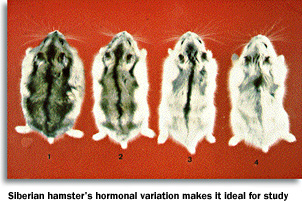| VOLUME 29, NUMBER 1 | THURSDAY, AUGUST 28, 1997 |
Hormone study involves new technique
Siberian hamsters used in research to identify brain chemical regulating prolactin
By LOIS BAKER
News Services Editor
A UB neuroendocrinologist is providing new insights into the cause of changes in blood levels of the hormone prolactin, which plays a role in regulating many vital human physiological functions.
 Supported by a grant from the National Science Foundation, Lori Badura, assistant professor of psychology, is attempting to identify the neurotransmitter that signals those changes. If successful, her research could lead to interventions to keep the hormone at optimum levels.
Supported by a grant from the National Science Foundation, Lori Badura, assistant professor of psychology, is attempting to identify the neurotransmitter that signals those changes. If successful, her research could lead to interventions to keep the hormone at optimum levels.
"Some medications�ones that increase dopamine, for example�can cause prolactin levels to be low," she says. "Too much or too little prolactin can cause infertility. It's important to know what neuro-chemicals are affecting any system because a change in one causes a change somewhere else.
"We already know prolactin's effects, but we don't know what causes the brain to regulate its production. If we can find the chemical signals that cause these changes, we can design a drug to regulate them. Knowing the chemical neurotransmitters that underlie each system would allow us to compensate for problems in any of them."
Prolactin is perhaps best known as the hormone responsible for stimulating mammalian milk production. Its lesser-known functions include activating the immune system in response to stress. It also plays a role in fertility.
Identifying brain chemical is key
It is another of prolactin's lesser-known effects�its role in regulating the seasonal molting cycle in such animals as the Siberian hamster�that drives Badura's research. Siberian hamsters turn from brown to white in winter and experience a corresponding drop in prolactin levels. Badura is attempting to identify the brain chemical that triggers this change. Once identified, the chemical could be manipulated to correct an existing hormonal imbalance.
The Siberian hamster is a convenient model for studying prolactin regulation because its hormonal variation is photosensitive�triggered by seasonal changes in amount of daylight. During long summer days, the hamster's coat is dark; as winter approaches and days become shorter, the coat changes to white. These seasonal light conditions can be simulated in the laboratory by adjusting the light level. The hamster's natural hormonal variation, which is small and occurs at the basal level, is easy to correlate with a specific stimulus.
Neurotransmitters involved
One of the neurotransmitters that Badura and colleagues are looking at is norepinephrine because its levels also appear to change under different light conditions and it is known to be involved in prolactin release.
"We don't know if this is coincidental, if other factors are involved, or if there is a real cause and effect," she says. "Once we establish a relationship, we can manipulate norepinephrine and see if prolactin changes. No one has done that yet."
Before Badura can move into that realm of discovery, however, she and her grad students must master the difficult technique of implanting two microinstruments in the hamsters so physiological changes can be measured. According to Badura, no researcher has yet been able to successfully implant both instruments and conduct dual analyses.
"If this technique becomes viable," she says, "it would permit a new direction in research that is very attractive to granting agencies. This will allow us to document any kind of physiological activity and physical state minute by minute. We will be able to answer many questions that we haven't been able to answer before."
Current Issue | Comments? | Archives | Search
UB Home | UB News Services | UB Today